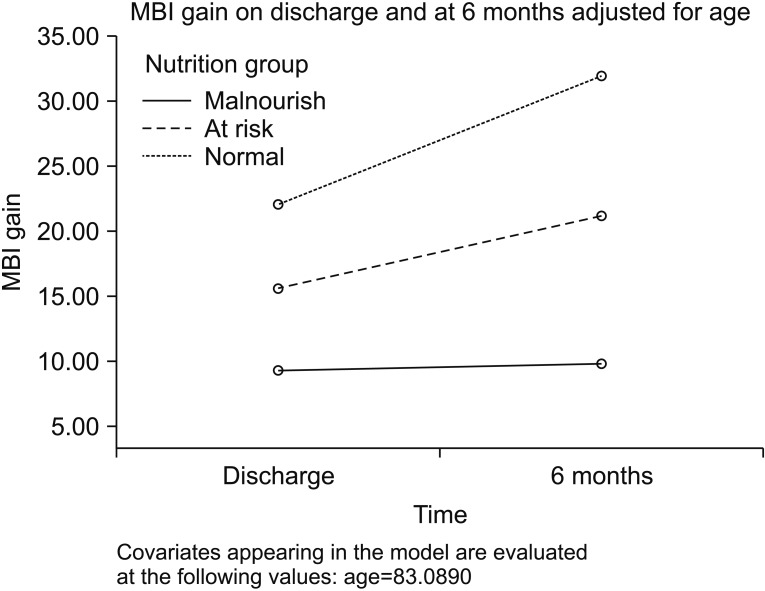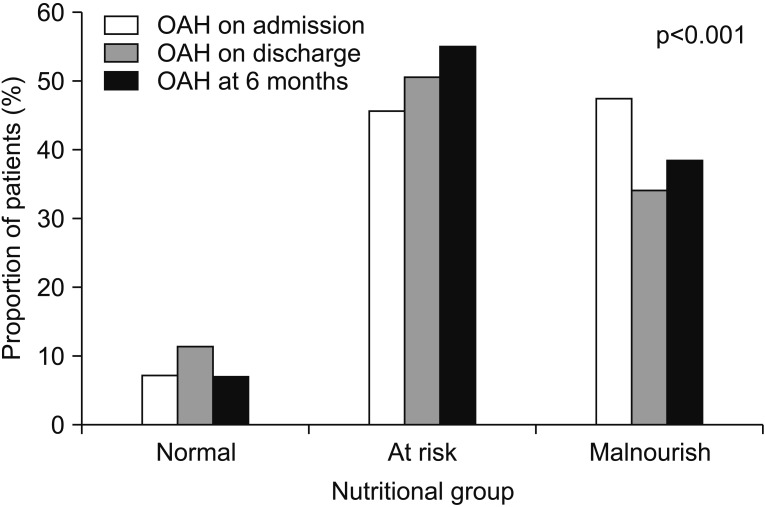Ann Rehabil Med.
2017 Dec;41(6):1005-1012. 10.5535/arm.2017.41.6.1005.
Effects of Nutritional Status on 6-Month Outcome of Hip Fractures in Elderly Patients
- Affiliations
-
- 1Department of Rehabilitation and Extended Care, Wong Tai Sin Hospital, Hong Kong. miuky@ha.org.hk
- KMID: 2400285
- DOI: http://doi.org/10.5535/arm.2017.41.6.1005
Abstract
OBJECTIVE
To identify the prevalence of malnutrition in elderly hip fracture and to investigate the relationship between hip fracture patients and malnutrition on functional recovery and mortality.
METHODS
All hip fracture patients age >65 years admitted to a rehabilitation unit were recruited from July 2015 to June 2016. Nutritional status was assessed by Mini-Nutritional Assessment Short-Form (MNA-SF) within 72 hours of admission. Patients were reassessed at 6 months for functional status and place of residence. Length of hospital stay, in-patient mortality rate, and 6-month mortality rate were also recorded.
RESULTS
There were 218 patients recruited. The mean age was 83.5±7.5 years. According the MNA-SF, 46 (21.1%) were well nourished, 115 (52.6%) were at risk of malnutrition, and 57 (26.1%) were malnourished. Malnourished individuals were significantly older, had lower Mini-Mental State Examination score and albumin level, were functionally more dependent and were more likely to reside in elderly care facility. A higher proportion of elderly care residents were at-risk or were malnourished on admission, discharge and at 6 months. Functional recovery was slower in the malnourished group. In-patient mortality was higher in malnourished individuals compared to those at risk of malnourishment and well-nourished individuals.
CONCLUSION
The prevalence of malnutrition is high and is associated with poor functional recovery and elderly care placement. Residents of elderly care facilities are especially at risk due a higher prevalence of malnourishment. Health authorities are encouraged to evaluate the dietetic component in elderly care facilities and initiate nutrition supplementation in their planning of healthcare resources.
Keyword
MeSH Terms
Figure
Reference
-
1. Miller CW. Survival and ambulation following hip fracture. J Bone Joint Surg Am. 1978; 60:930–934. PMID: 701341.
Article2. Magaziner J, Hawkes W, Hebel JR, Zimmerman SI, Fox KM, Dolan M, et al. Recovery from hip fracture in eight areas of function. J Gerontol A Biol Sci Med Sci. 2000; 55:M498–M507. PMID: 10995047.
Article3. Shyu YI, Chen MC, Liang J, Wu CC, Su JY. Predictors of functional recovery for hip fractured elders during 12 months following hospital discharge: a prospective study on a Taiwanese sample. Osteoporos Int. 2004; 15:475–482. PMID: 15205719.
Article4. Charlton KE, Nichols C, Bowden S, Lambert K, Barone L, Mason M, et al. Older rehabilitation patients are at high risk of malnutrition: evidence from a large Australian database. J Nutr Health Aging. 2010; 14:622–628. PMID: 20922337.
Article5. Olofsson B, Stenvall M, Lundstrom M, Svensson O, Gustafson Y. Malnutrition in hip fracture patients: an intervention study. J Clin Nurs. 2007; 16:2027–2038. PMID: 17419798.
Article6. Chen CC, Schilling LS, Lyder CH. A concept analysis of malnutrition in the elderly. J Adv Nurs. 2001; 36:131–142. PMID: 11555057.
Article7. Allison SP. Malnutrition, disease, and outcome. Nutrition. 2000; 16:590–593. PMID: 10906565.
Article8. Dawson-Hughes B. Interaction of dietary calcium and protein in bone health in humans. J Nutr. 2003; 133:852S–854S. PMID: 12612168.
Article9. Bonjour JP. Dietary protein: an essential nutrient for bone health. J Am Coll Nutr. 2005; 24(6 Suppl):526S–536S. PMID: 16373952.
Article10. Paillaud E, Bories PN, Le Parco JC, Campillo B. Nutritional status and energy expenditure in elderly patients with recent hip fracture during a 2-month follow-up. Br J Nutr. 2000; 83:97–103. PMID: 10743488.
Article11. Neumann M, Friedmann J, Roy MA, Jensen GL. Provision of high-protein supplement for patients recovering from hip fracture. Nutrition. 2004; 20:415–419. PMID: 15105027.
Article12. Nikkel LE, Fox EJ, Black KP, Davis C, Andersen L, Hollenbeak CS. Impact of comorbidities on hospitalization costs following hip fracture. J Bone Joint Surg Am. 2012; 94:9–17. PMID: 22218377.
Article13. Foss NB, Jensen PS, Kehlet H. Risk factors for insufficient perioperative oral nutrition after hip fracture surgery within a multi-modal rehabilitation programme. Age Ageing. 2007; 36:538–543. PMID: 17660529.
Article14. Norman K, Pichard C, Lochs H, Pirlich M. Prognostic impact of disease-related malnutrition. Clin Nutr. 2008; 27:5–15. PMID: 18061312.
Article15. Volkert D, Berner YN, Berry E, Cederholm T, Coti Bertrand P, Milne A, et al. ESPEN Guidelines on Enteral Nutrition: Geriatrics. Clin Nutr. 2006; 25:330–360. PMID: 16735082.
Article16. Milte R, Miller M. Dietetic care of hip fracture patients across Australia: are we doing enough? Nutr Diet. 2011; 68:214–220.
Article17. White JV, Guenter P, Jensen G, Malone A, Schofield M, et al. Academy Malnutrition Work Group. Consensus statement: Academy of Nutrition and Dietetics and American Society for Parenteral and Enteral Nutrition: characteristics recommended for the identification and documentation of adult malnutrition (undernutrition). JPEN J Parenter Enteral Nutr. 2012; 36:275–283. PMID: 22535923.18. Kaiser MJ, Bauer JM, Ramsch C, Uter W, Guigoz Y, Cederholm T, et al. Validation of the Mini Nutritional Assessment short-form (MNA-SF): a practical tool for identification of nutritional status. J Nutr Health Aging. 2009; 13:782–788. PMID: 19812868.
Article19. Kwok T, Whitelaw MN. The use of armspan in nutritional assessment of the elderly. J Am Geriatr Soc. 1991; 39:492–496. PMID: 2022801.
Article20. Bell JJ, Bauer JD, Capra S, Pulle RC. Concurrent and predictive evaluation of malnutrition diagnostic measures in hip fracture inpatients: a diagnostic accuracy study. Eur J Clin Nutr. 2014; 68:358–362. PMID: 24398643.
Article21. Velasco C, Garcia E, Rodriguez V, Frias L, Garriga R, Alvarez J, et al. Comparison of four nutritional screening tools to detect nutritional risk in hospitalized patients: a multicentre study. Eur J Clin Nutr. 2011; 65:269–274. PMID: 21081958.
Article22. Gout BS, Barker LA, Crowe TC. Malnutrition identification, diagnosis and dietetic referrals: are we doing a good enough job? Nutr Diet. 2009; 66:206–211.
Article23. Nematy M, Hickson M, Brynes AE, Ruxton CH, Frost GS. Vulnerable patients with a fractured neck of femur: nutritional status and support in hospital. J Hum Nutr Diet. 2006; 19:209–218. PMID: 16756536.
Article24. Hoekstra JC, Goosen JH, de Wolf GS, Verheyen CC. Effectiveness of multidisciplinary nutritional care on nutritional intake, nutritional status and quality of life in patients with hip fractures: a controlled prospective cohort study. Clin Nutr. 2011; 30:455–461. PMID: 21342737.
Article25. Koren-Hakim T, Weiss A, Hershkovitz A, Otzrateni I, Grosman B, Frishman S, et al. The relationship between nutritional status of hip fracture operated elderly patients and their functioning, comorbidity and outcome. Clin Nutr. 2012; 31:917–921. PMID: 22521470.
Article26. Hedstrom M, Ljungqvist O, Cederholm T. Metabolism and catabolism in hip fracture patients: nutritional and anabolic intervention: a review. Acta Orthop. 2006; 77:741–747. PMID: 17068704.
- Full Text Links
- Actions
-
Cited
- CITED
-
- Close
- Share
- Similar articles
-
- Functional Recovery after Operative Treatment of Hip Fractures in the Elderly
- Effects of Enternal Nutritional Support on Tube-fed Elderly Patients
- Analysis of Missed Fractures by Bone Scan in Elderly Hip Fracture Patients with Osteoporosis
- Postoperative Rehabilitation after Hip Fracture: A Literature Review
- Nutritional Care for the Elderly



